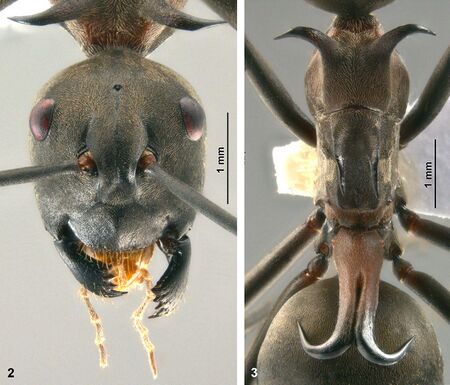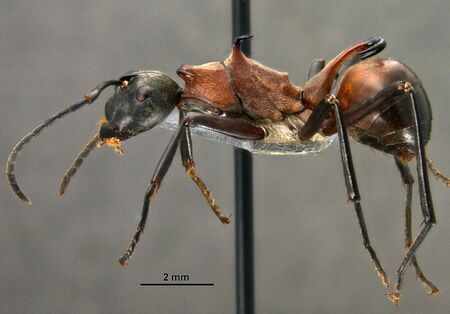Key to Polyrhachis s.str. of Malay Peninsula
Key to workers of Polyrhachis s.str. from the Malay Peninsula (from Zettel (2019), partly following Hung (1970) and Kohout (2014)).
See also the Key to Polyrhachis (Polyrhachis) species, which includes these and related species world-wide.
1
- Petiolar spines strongly diverging from base. Pronotal spines stout. Large species with abundant long setae => Polyrhachis ypsilon
- Petiolar spines parallel over most of their length; pronotal spines slender (Figs. 3, 6, 9, 13). Size and pilosity variable => 2
2
return to couplet #1
- Gaster tergites shiny (Fig. 4) with sparse shallow punctures, a reticulate microsculpture of interspaces evanescent. Propodeum with a single low tubercle at midline (Fig. 6). Head (except clypeus margin), mesosoma, petiole, and gaster tergites 1–2 without standing setae. Pronotal spines pointing posteriorly => Polyrhachis lacroixi
- Gaster tergites matt (Fig. 1), densely and finely punctured. Propodeum with paired structures. Either body with numerous standing setae or pronotal spines pointing laterally => 3
3
return to couplet #2
- Propodeal dorsum laterally rounded, posteriorly with pair of short, closely set teeth or (rarely) sharp tubercles, without transverse carina. Median ocellus usually lacking. Gaster anteriorly pale reddish. Pilosity variable => Polyrhachis olybria
- Propodeal dorsum posteriorly without short teeth, with transverse carina (Fig. 3) which can be medially interrupted (if reduced to short transverse tubercles in some specimens of Polyrhachis bihamata, then more widely separated). Median ocellus usually present (Fig. 5) => 4
4
return to couplet #3
- Head (except clypeus margin), mesosoma, petiole, and gaster tergites 1–2 without standing setae (Figs. 1–3). Pronotal spines moderately curved, pointing laterally (Fig. 3). Propodeal dorsum laterally with obtuse edge, posterior carina complete, laterally elevated (Fig. 3). Gaster black => Polyrhachis dostali
- Body with numerous standing setae. Propodeal dorsum laterally rounded; posterior carina incomplete. Pronotal spines strongly curved, pointing posteriorly. Gaster anteriorly pale reddish => Polyrhachis bihamata
References
- Hung, A. C. F. 1970. A revision of ants of the subgenus Polyrhachis Fr. Smith (Hymenoptera: Formicidae: Formicinae). Orient. Insects 4: 1-36.
- Kohout, R.J. 2014. A review of the subgenus Polyrhachis (Polyrhachis) Fr. Smith (Hymenoptera: Formicidae: Formicinae) with keys and description of a new species. Asian Myrmecology 6, 1–31.
- Zettel, H. 2019. Two new species from Malaysia and further taxonomic notes on Polyrhachis s.str. (Hymenoptera: Formicidae). Zeitschrift der Arbeitsgemeinschaft Österreichischer Entomologen 71: 57-73.





